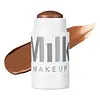What's inside
What's inside
 Key Ingredients
Key Ingredients

 Benefits
Benefits

 Concerns
Concerns

 Ingredients Side-by-side
Ingredients Side-by-side

Ricinus Communis Seed Oil
MaskingC12-15 Alkyl Benzoate
AntimicrobialHelianthus Annuus Seed Oil
EmollientHelianthus Annuus Seed Wax
Skin ConditioningCoconut Alkanes
EmollientSilica
AbrasiveEuphorbia Cerifera Wax
Kaolin
AbrasiveMangifera Indica Seed Butter
Skin ConditioningCitrus Aurantium Dulcis Peel Wax
Skin ConditioningPrunus Armeniaca Kernel Oil
MaskingCoco-Caprylate/Caprate
EmollientBis-Stearyl Dimethicone
EmollientParfum
MaskingHydrogenated Vegetable Oil
EmollientIsopropyl Titanium Triisostearate
EmollientTocopheryl Acetate
AntioxidantSorbitan Tristearate
EmulsifyingCI 77891
Cosmetic ColorantIron Oxides
Ricinus Communis Seed Oil, C12-15 Alkyl Benzoate, Helianthus Annuus Seed Oil, Helianthus Annuus Seed Wax, Coconut Alkanes, Silica, Euphorbia Cerifera Wax, Kaolin, Mangifera Indica Seed Butter, Citrus Aurantium Dulcis Peel Wax, Prunus Armeniaca Kernel Oil, Coco-Caprylate/Caprate, Bis-Stearyl Dimethicone, Parfum, Hydrogenated Vegetable Oil, Isopropyl Titanium Triisostearate, Tocopheryl Acetate, Sorbitan Tristearate, CI 77891, Iron Oxides
Isodecyl Isononanoate
EmollientSilica
AbrasiveC12-15 Alkyl Benzoate
AntimicrobialOctyldodecyl Stearoyl Stearate
EmollientIsodecyl Neopentanoate
EmollientPolyethylene
AbrasiveMethyl Methacrylate Crosspolymer
Dicalcium Phosphate
AbrasiveLimnanthes Alba Seed Oil
Skin ConditioningSynthetic Fluorphlogopite
Aluminum Hydroxide
EmollientBHT
AntioxidantGardenia Florida Fruit Extract
Skin ConditioningHelianthus Annuus Seed Oil
EmollientNelumbo Nucifera Flower Extract
Skin ConditioningNymphaea Odorata Root Extract
RefreshingPentaerythrityl Tetra-Di-T-Butyl Hydroxyhydrocinnamate
AntioxidantTocopheryl Acetate
AntioxidantUltramarines
CI 77492
Cosmetic ColorantCI 77491
Cosmetic ColorantCI 77499
Cosmetic ColorantCI 77891
Cosmetic ColorantCI 42090
Cosmetic ColorantIsodecyl Isononanoate, Silica, C12-15 Alkyl Benzoate, Octyldodecyl Stearoyl Stearate, Isodecyl Neopentanoate, Polyethylene, Methyl Methacrylate Crosspolymer, Dicalcium Phosphate, Limnanthes Alba Seed Oil, Synthetic Fluorphlogopite, Aluminum Hydroxide, BHT, Gardenia Florida Fruit Extract, Helianthus Annuus Seed Oil, Nelumbo Nucifera Flower Extract, Nymphaea Odorata Root Extract, Pentaerythrityl Tetra-Di-T-Butyl Hydroxyhydrocinnamate, Tocopheryl Acetate, Ultramarines, CI 77492, CI 77491, CI 77499, CI 77891, CI 42090
 Reviews
Reviews

Alternatives
Ingredients Explained
These ingredients are found in both products.
Ingredients higher up in an ingredient list are typically present in a larger amount.
C12-15 Alkyl Benzoate is made up of Benzoic Acid and long chain alcohols. It has a low molecular weight.
C12-15 Alkyl Benzoate is an emollient and texture enhancer. Due to its solubility, it is often used in sunscreens to help evenly distribute active ingredients.
As an emollient, C12-15 Alkyl Benzoate helps soften and hydrate your skin. Emollients create a film on your skin that traps moisture within.
This ingredient has been reported to cause eye irritation.
Learn more about C12-15 Alkyl BenzoateCi 77891 is a white pigment from Titanium dioxide. It is naturally found in minerals such as rutile and ilmenite.
It's main function is to add a white color to cosmetics. It can also be mixed with other colors to create different shades.
Ci 77891 is commonly found in sunscreens due to its ability to block UV rays.
Learn more about CI 77891Helianthus Annuus Seed Oil is the oil derived from the seeds of a Sunflower. Sunflower seed oil is non-fragrant. It is an emollient, meaning it helps to soften the skin.
Sunflower seed oil contains many fatty acids. The fatty acids found in sunflower seeds include (from highest amount to least): linoleic acid, myristic acid, palmitic acid, stearic acid, arachidic acid, oleic acid, and linolenic acid.
These fatty acids help the skin create ceramides. Ceramides play a role in repairing the skin barrier.
Helianthus Annuus Seed Oil helps moisturize the skin. This in turn helps the skin look more rejuvenated and smoother.
Sunflowers are rich in vitamin E.
Historians believe Indigenous cultures of North America domesticated sunflowers before corn. Thus they relied on sunflower oil for a variety of uses. One such use is moisturizing skin and hair.
Sunflower seed oil may not be fungal acne safe. We recommend speaking with a professional if you have any concerns.
Learn more about Helianthus Annuus Seed OilSilica, also known as silicon dioxide, is a naturally occurring mineral. It is used as a fine, spherical, and porous powder in cosmetics.
Though it has exfoliant properties, the function of silica varies depending on the product.
The unique structure of silica enhances the spreadability and adds smoothness, making it a great texture enhancer.
It is also used as an active carrier, emulsifier, and mattifier due to its ability to absorb excess oil.
In some products, tiny microneedles called spicules are made from silica or hydrolyzed sponge. When you rub them in, they lightly polish away dead skin layers and enhance the penetration of active ingredients.
Learn more about SilicaTocopheryl Acetate is AKA Vitamin E. It is an antioxidant and protects your skin from free radicals. Free radicals damage the skin by breaking down collagen.
One study found using Tocopheryl Acetate with Vitamin C decreased the number of sunburned cells.
Tocopheryl Acetate is commonly found in both skincare and dietary supplements.
Learn more about Tocopheryl Acetate